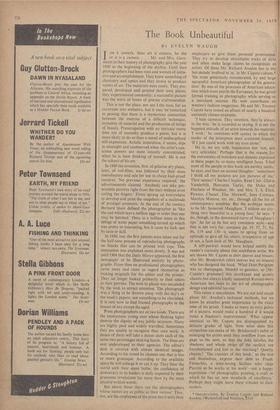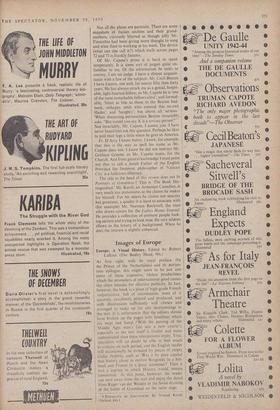The Book Unbeautiful
By EVELYN WAUGH
IAM a camera, thou art a camera, he she or it is a camera. . . . Mr. and Mrs. Gern- sheim in their history of photography give the year 1880 as the beginning of the decline. Until then photographers had been men and women of initia- tive and accomplishment. They knew something of chemistry and optics and they strove to produce works of art. The materials were costly. They pre- pared, developed and. printed their own plates; they experimented constantly; a successful picture was the work of hours of precise craftsmanship.
This is not the place, nor am I the man, for an excursion into aesthetics, but it may be remarked in passing that there is a mysterious connection between the exercise of a difficult technique, economy of material and the production of things of beauty. Preoccupation with an intricate metre does not of necessity produce a poem, but it is more likely to do so than a mood of undisciplined self-expression. Artistic inspiration, it seems, slips in unsought and unobserved when the artist's con- scious powers are most intently concentrated, when he is least thinking of himself. He is not the subject of his art.
In 1880 the invention, first, of gelatine dry plates, later, of roll-films, was followed by their mass manufacture and sale for use in cheap fool-proof cameras. 'No previous experience required,' the advertisements claimed. 'Anybody can take pre- sentable pictures right from the start without even soiling the fingers.' Firms sprang up everywhere to develop and print the snapshots of a multitude of prodigal amateurs. At the end of the century Bernard Shaw defined the photographer as 'like the cod which lays a million eggs in order that one may be hatched.' Once in a million times in this deluge of waste paper something turned up which was pretty or interesting, but it came by luck, not by taste or skill.
In 1880, too, the first patents were taken out for the half-tone process of reproducing photographs on blocks that can be printed with type. This innovation was exploited more slowly. It was not until 1904 that the Daily Mirror appeared, the first newspaper to be illustrated entirely by photo- graphs. From then on professional photographers came more and more to regard themselves as making originals for the editor and the printer. They no longer looked primarily to their sitters as their patrons. The wish to please was succeeded by the wish to attract attention. The photograph
• was a thing to be thrown away with the day's or the week's papers; not something to be cherished. It is rare now to find framed photographs in the houses of any except the aged.
Press photographers are of two kinds. There are the anonymous young men whose flashing lights destroy the dignity of any public occasion. Many are highly paid and widely travelled. Sometimes they are unable to recognise their own work. A dozen of them will take a dozen shots each of the same two personages shaking hands. The films are sent undeveloped to their agencies. The editor's desk is covered with almost identical images. According to his mood he chooses one that is less or more grotesque. According to the available space he will enlarge it or cut it up. They litter the world with their spent bulbs; the confidence of democracy in its leaders is daily impaired by their gruesome revelations far more than by the most abusive written words.
But above those there are the photographers whose names are as public as their victims'. They, too, arc the employees of the press but it suits their
employers to give them personal prominence. They try to develop identifiable tricks of style and often make large claims to recognition as artists. Of these Mr. Richard Avedon has in the last decade 'evolved to Se,' in Mr. Capote's idiom,* `the most generbusly remunerated, by and large successful American photographer of his genera- tion.' By one of the processes of 'American educa- tion which must puzzle the European, he was given formal training in photography while serving as a merchant seaman. He now contributes to women's fashion magazines. He and Mr. Truman Capote have issued an album of nearly a hundred anxiously chosen examples.
'I hate cameras. They interfere, they're always in the way,' he is recorded as sayffig. It is not the happiest attitude of an artist towards his material. `I wish :' he continues with syntax to which the reader of the letterpress must accustom himself, 'If I just could work with my eyes alone.'
He is, we are told, loquacious but 'not, not very articulate.' Perhaps that is the ,reason for the. extremities of boredom and distaste expressed in these pages by so many intelligent faces. '1 feel most of the people in this book are earthly saints,' he says, and then on second thoughts : 'sometimes I think all my pictures are just pictures of me.' Their names? Charles Chaplin, Rend Clair, Gloria Vanderbilt, Henrietta Tiarks, the Duke and Duchess of Windsor, Mr. and Mrs. T. S. Eliot, Picasso, Chanel, Elsa Maxwell, Jean Cocteau, Marilyn Monroe, etc. etc., through all the list of contemporary notables. But the archtype seems to be Mr. Somerset Maugham. 'I seldom see any- thing very beautiful in a young face,' he says. 'I do, though, in the downward curve of Maugham's lips.' So far as he has any consistent style—and that is not very far; compare pp. 19, 37, 71, 84, 86, 119 and 150—it seems to spring from an aptitude to give all his sitters, irrespective of age or sex, a faint look of Mr. Maugham.
A self-portra,it would have helped satisfy the reader's curiosity about this multiform artist. We are shown Mr. Capote in shirt sleeves and braces; also Mr. Brodovitch (shirt sleeves but no braces) who has designed the book. 'What Dom' PerigriOn was to champagne, Mendel to genetics, so [Mr. Capote's grammar] this overkeyed and quietly chaotic but always kindly mannered Russian-born American has ..been to the art of photographic design and editorial lay-out.'
This raises a speculation. We are not told much about Mr. Avedon's technical methods, but we know he attaches great importance to the exact tone of his prints. 'I make as many as sixty prints of a picture, would make a hundred if it would make a fraction's improvement.' What appear identical to Mr. Capote are distinguished by delicate grades of light. Now what does this scrupulous eye make of Mr. Brodovitch's habit of enlarging his prints until they overflow from one page to the next, so that the fold falsifies the shadows and whole strips of the surface are foreshorlened and lost in the stitching? Quietly chaotic? 'The creators of this book,' as the trio call themselves, express their debt to 'Frank Finocchio, a wine-loving Sicilian who sings Puccini as he works at his work'--not a happy expression—`of photographic printing, a craft in which he has set new standards of excellence.' Perhaps they might leave these tributes to their readers.
* OasEavATioNs. By Truman Capotc and Richard Avedon. (Weidenfeld and Nicolson„ t3s.)
Not all the plates are portraits. There are some snapshots of Italian urchins and their grand- mothers, curiously blurred as though jolly Mr. Finocchio had been giving more thought to song and wine than to working at his work, The device (what can one call it?) which trails across pages 72 and 73 is frankly fatuous.
Of Mr. Capote's prose it is hard to speak temperately. It is some sort of jargon quite un- familiar to me. Of the information he seeks to convey, I am no judge. I have a distant acquain- tance with a few of the subjects. Mr. Cecil Beaton I have known, not well, for nearer fifty than forty years. He has always struck me as a genial, hospit- able, light-hearted fellow; to Mr. Capote he is 'one of the most remarkable fellows alive'; and formid- able, 'bitter as bile to those in the Beaton bad- book, unhappy souls who entered this no-exit Hades'; and 'haughty'; but above all 'serious.' 'When discussing personalities Beaton invariably, asks, "But would you say X is a serious person?" ' Not invariably, Mr. Capote, I assure you. 1 have never heard him ask this question. Perhaps he likes to pull their legs a little when he goes to America.
Fr. D'Arcy I know better. I know, for example, that this is the way to spell his name as Mr. Capote does not. I know he did not instruct Mr. Graham Greene, as Mr. Capote states, for the Church. And from general knowledge I must point out that to call a Jesuit Father of the English Province the foremost philosopher of 'Vatican City' is a ludicrous illiteracy.
The title at the head of this review does not fit Portraits of Greatness.t This is 'The Book Dis- tinguished.' Mr. Karsh, an Armenian Canadian, is very much less pretentious in the claims he makes for himself. For his sitters he claims not sanctity but greatness, a quality it is hard to associate with (for example) Mr. Norman Rockwell, the man who draws covers for the Ladies Home Journal. He provides a collection of eminent people look- ing earnest and trying to look wise. He very seldom allows us the luxury of a background. When he does the interest is slightly enhanced.







































































 Previous page
Previous page